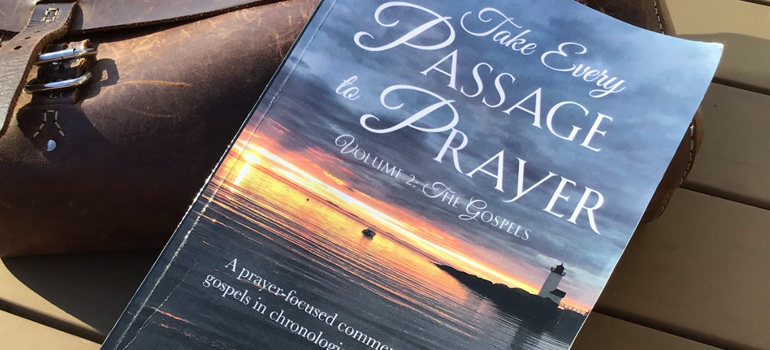The Gramazin Blog

Jesus Walks on Water
Take Every Passage to Prayer - Volume 2, The Gospels
Wednesday July 24, 2024
Matthew 14:22-36, Mark 6:45-56, John 6:16-21
Father, teach me to pray not just about present and future things. Teach me to pray also for events that have just occurred. I'm sure Jesus prayed about the feeding of the "5,000" after the event was over. Similarly, help me to pray for encounters I have recently had with people, that You will use what I did and said to transform their lives. Father, I know that You will test my faith from time to time. I know that You may test my faith to expose to me that I'm not really as strong as I think I am. Father, please help me to learn from those lessons. Please help me to not lose faith in You in times of trouble. Instead, please help me to become even more dependent upon You in dark and scary times. Father, I want to be courageous and brave in the storms of life. Finally, please help me to have truth faith in You and not merely one that comes from intellectual reason. Amen.
Father, the crowd of “5,000” had not dispersed. Jesus instructed His disciples to get back into the boat and return to the other side of the Sea of Galilee.
“But what about you?”
“I’m going to dismiss the crowd and spend time with my Father,” Jesus replied. “I’ll catch up with you.”
This must have been perplexing to the disciples. How was Jesus going to catch up with them? There were only two possibilities the disciples could imagine. Either Jesus would find someone else with a boat who was going to the same shore or Jesus would take a long walk along the shoreline across the top of the Sea of Galilee.
Jesus walked up the mountain to spend many hours in prayer throughout the night. Father, I have a few thoughts about this:
- There are not many people hanging around at higher elevations on a mountain at night. Jesus wanted solitude.
- There are many passages in the Bible where You meet with people on a mountain. Jesus longed to be with You.
- Jesus prayed about the feeding of the “5,000” that had just occurred. He prayed that the crowd would receive Him as their Savior. He prayed that their eyes and ears would be opened and that they would consider that He was the “Bread of Life.”
- Jesus asked for another lesson in faith for the disciples. He asked You to send a wind upon the Sea of Galilee which would literally “rock the boat” of the disciples. He asked for Your help and guidance as He walks across the water and then encounters the frightened disciples.
The strong wind the disciples encountered must have been a westerly wind, coming from the Mediterranean, blowing towards the east. This is confirmed in the text when the text says the wind was “against” the boat. This would explain how the disciples had not been able to navigate across the Sea of Galilee after having been rowing the boat for over eight hours.
Shortly before dawn, Jesus walked down the mountain and began walking across the water to reach the other side. Mark tells us that Jesus was not walking directly towards the disciple’s boat. He was walking on a path that would pass their boat. However, the course that Jesus was on was close enough to them to lead them to believe He was walking directly to their boat. The disciples were exhausted from rowing and, no doubt given human nature, bickering about whose turn it was to row and whether each disciple had given their 100% effort. They looked across the water and saw the figure of someone walking on the water.
“Dude, something is walking on the water.”
“Did you have a little too much wine?”
“No, I’m serious, dude. Look.”
“That must be a boat.”
“No, I swear! Whatever it is, it’s walking on the water and it’s coming towards us.”
“I see something. It looks like a man.”
“Well, it can’t be a man. It must be a g-g-g-g-ghost.”
Word spread across the boat that they were being stalked by a ghost. None of the men apparently stopped to think that it might be Jesus walking on the water and, if so, all will be fine.
Father, the disciples have not yet been filled with the Holy Spirit. The disciples are not yet true believers in Jesus Christ. Their radical spiritual transformation will take place after they see the risen Jesus. These men are still worldly. Therefore, they still believe in the superstitions that are common throughout their society. It seemed quite appropriate and rational for them to be terrified of an approaching ghost that was going to do them harm.
Jesus had compassion on them. Though the text doesn’t say this, I can imagine Jesus thinking something like, “Father, forgive them. For they don’t understand how foolish they are.”
As Jesus approached near to the boat, the men were screaming in fear, likely cowering in a huddle inside the rolling boat, and perhaps grabbing oars to fight off the ghost. Jesus said,
“Take courage! It is I. Don’t be afraid. (NIV)”
Father, we all have adversity in our lives. Scary things happen to us. We worry. We become anxious. Sometimes we experience panic. In the darkest of nights, Jesus speaks to us, saying:
“Take courage! It is I. Don’t be afraid.”
Jesus tells us to be strong and to persevere when difficulties come into our lives. We are not to give up. We are not to run away. We are not to abandon our faith in the goodness of His character. We are not to abandon our faith in His ability to rescue us and deliver us. We are to be confident that He who has begun a good work in us will complete it, regardless of the circumstances, for His honor and glory. We are to resist the devil and tell him, in the name of Jesus Christ, that we are not going to believe all things are lost. We are to know that through our relationship with Jesus we can have an abundance of peace even when there are scary things walking across the water towards us in the dark.
“Lord, if it’s you,” Peter replied, “tell me to come to you on the water. (NIV)”
Peter has revealed to us something particularly important that is not otherwise highlighted in the gospels: Jesus repeatedly calls His disciples to be brave and courageous. Given the cowardice that the disciples displayed during Jesus’ last week, it is reasonable to believe Jesus saw their timidity and taught them to be the opposite. It must have been a common theme in His teachings because Peter is suggesting it has become a signature of who Jesus is.
“If you are really Jesus, you would tell me to do something really brave right now.”
“Come,” he said (NIV).
It was Jesus.
Spontaneous and impulsive Peter stepped out of the boat and walked to Jesus on the water. He didn’t think about what He was doing. He didn’t do an analysis of the pros and cons of stepping onto water. In blind trust in the saving power of Jesus, Peter stepped out onto the water. This is an illustration of the acceptance of Jesus Christ as our Savior. Salvation does not come as a result of an intellectual process that concludes that becoming a follower of Jesus is the reasonable decision after a carefully engineered scientific analysis. Salvation comes when we take a running leap of faith into the arms of Jesus Christ.
But when he saw the wind, he was afraid and, beginning to sink, cried out, “Lord, save me! (NIV)”
However, many believers, after taking that leap of faith into the arms of Jesus, look around them and see the scary things of life and they panic. They squirm to be released from Jesus’ loving arms so that they can run far away from dangers before them. They feel safer in flight from faith in Jesus than staying in His arms has He protects them in the midst of the dangers.
Immediately Jesus reached out his hand and caught him. “You of little faith,” he said, “why did you doubt? (NIV)”
It turns out Peter’s amazing display of spontaneous faith had no depth to it. He quickly took his eyes off of Jesus and began to reason, “uh, this isn’t good. I’m walking on water. I’m going to drown!” Our intellect is often not a friend of our faith. The two are often diametrically opposite of each other. Faith is so uncommon in our world because we’ve all bought into the idea that our reason is to rule our hearts and minds. Thank you, Enlightenment!
Father, I suspect that the disciples were feeling rather good about themselves as they distributed bread to over 10,000 people on the hillside. They were in Jesus’ inner circle. They were His disciples. They were proud. They felt superior. They were overconfident. Jesus engineered the disciples visit by a “walking ghost on the water” to wake them up to the reality that their faith in Him, and their courage, was very weak indeed. In reality, they were more like frightened children than men of renown and honor.
Jesus climbed into the boat and commanded the wind to die down. The lesson had been learned. Humbled, the disciples worshipped him, saying:
“Truly you are the Son of God. (NIV)”
Mark concludes this story by informing us what is obvious from the text – the disciples had not learned the lesson at the feeding of the “5,000” that Jesus is the Bread of Life, the Son of God. There’s no need for fear or panic when the Son of God is our loving Father.
When the boat landed at Gennesaret , Jesus was identified and, in short order, word spread throughout the region that He had returned. Many people came to Jesus bringing their sick friends and family members. The people begged Jesus to let them simply touch the edge of His cloak (a jacket in 21st century). He had compassion on them and everyone who touched it was healed. Amen.
This is an imagined dialogue. The text informs us this conversation did occur but does not give us the actual words spoken.
Where did God meet with His people? On His mountain. See Genesis 22, Exodus 3, Exodus 4, Exodus 18, Exodus 19, Exodus 24, Exodus 34***, Numbers 10, Numbers 20, Numbers 27, Deuteronomy 5, Deuteronomy 9, Deuteronomy 33, 1 Kings 19, Psalm 2, Psalm 3, Psalm 15, Psalm 24, Psalm 36, Psalm 43, Psalm 48, Psalm 87, Psalm 99, Isaiah 2, Isaiah 11, Isaiah 25, Isaiah 27, Isaiah 30, Isaiah 40***, Isaiah 56, Isaiah 57, Isaiah 65, Jeremiah 31, Ezekiel 20, Ezekiel 43, Daniel 11, Micah 4, Zechariah 8, Matthew 28, Mark 9.
The eight plus hours is calculated based on two statements in the text: 1) Jesus dispersed the crowd in the evening so they could go home and 2) Jesus walked on the water just before dawn.
The Sea of Galilee is 8 miles wide at its greatest width, which would take about 2 to 3 hours to walk across, given humans walk about 3 MPH. The text in John tells us that the disciples were roughly three to four miles out to sea, about halfway across. It probably took Jesus at least an hour and a half to walk down the mountain and then across the water to where the men were in the boat. Therefore, it is reasonable to conclude that the disciples saw a figure walking towards them for well over a half-hour, heightening their fear and anxiety. The sighting of the “ghost” was not just a few minutes before His arrival at the boat.
It is likely that Jesus body went up and down as He walked on the swells and waves. Given the turbulence of the sea at the time, it is unlikely Jesus walked on still and flat water, as one would walk on a paved road. When He was still far away, it is likely that Jesus would frequently disappear from view when a swell or wave blocked the disciples view of Him. This would only heighten their anxiety that the person they saw was a ghost, flickering in and out of visibility.
The belief in ghosts was widespread in Roman culture. It was believed that the souls of the dead who had not been properly buried would haunt the living until their remains were properly buried. Roman writers Plutarch, Pliny the Younger, Pliny, Plautus, and Lucian all shared accounts of the occupation of buildings by ghosts. When Jesus appeared to the disciples after His resurrection, their first conclusion was that He was a ghost (Luke 24:37-39). How do we reconcile the disciple’s belief in ghosts with Jesus’ new teaching about the resurrection of the dead through Him? People of that day believed the souls of ghosts ceased to function once their bodies were properly buried. Jesus preached that our souls live forever and dwell either with Him, where we will be reunited with our now perfect bodies, or in that other place.
There is no mention of the women who supported Jesus in ministry. We read in John 6:22 that only one boat came across the water to the site of the feeding of the “5,000”. It was the boat Jesus was in with His disciples. Therefore, the women on Jesus’ team did not travel with the guys and were not present for the feeding of the “5,000”.







